mobile View, to the German Version tap the flag


- Part of the United Kingdom of Great Britain and Northern Ireland
- with own legislation
- own name in Welsh: Cymru
• Flags
• historical Flags
• Meaning/Origin of the Flag
• Coat of Arms
• Meaning/Origin of the Coat of Arms
• Map
• Numbers and Facts
• History
• Origin of the Country's Name
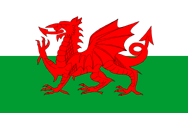
since 1959,
Flag of Wales
ratio = 3:5,
Source, by:
Corel Draw 4





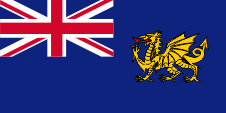
since 2017,
Flag for governmental vessels
ratio = 1:2,
Source, by:
Wikipedia (EN)



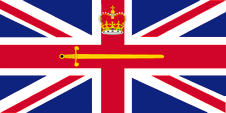
Flag of the Lord High Commissioner of Wales
ratio = 1:2,
Source, by:
Flags of all Nations



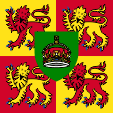
Flag of the Prince of Wales
ratio = 1:1,
Source, by:
Flags of all Nations



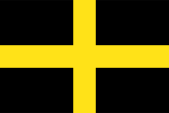
Flag of Saint David
(unofficial national flag)
ratio = 2:3,
Source, by:
Wikipedia (EN)






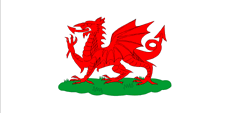
1907–1953,
Flag of Wales
ratio = 1:2,
Source, by:
World Statesmen



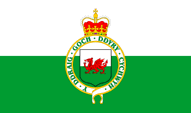
1953–1959,
Flag of Wales
ratio = 3:5,
Source, by:
World Statesmen




Wales no longer uses its own heraldic symbols. All of today’s colours and symbols are of English origin. The actual colours of Wales’ coat of arms are yellow and red, as the English. In about 1500 the Welsh dragon, a very old symbol, was combined with the green-white Tudor colours to make up today’s flag. Wales is Celtic territory and the Celts actually use flags and coats of arms in their national colors of black and white. This is preserved, however, only in the Bretagne (Brittany) and in Cornwall, with limited usage Scotland. All other Celtic territories have borrowed their heraldry from their respective sovereigns or imported them from other cultural circles. The British Northern Islands (Nordic Islands) use Scandinavian models, Ireland is influenced by the French Tricolor, Wales and the Isle of Man have taken English heraldry. In the course of time Wales was at the time of the establishment of the United Kingdom a full constituent member of England (a subjected region), and, due to this, had never an opportunity to contribute – albeit her foreign heraldry – anywhere to the English flag or to the flag of the United Kingdom. That Wales appears today as "having equal rights" in the United Kingdom, is only owed to the rise Welsh Nationalism in the 19th and 20th centuries so that it enjoys limited autonomy since 1912 and has its own regional parliament since 1999. Only in recent years has a flag established itself as a symbol of Welsh national identity. It is the Flag of Saint David. The image of the flag was taken from the Coat of Arms of the Diocese of St. David, golden cross on black. It is used by nationalists, but also by the Christian Party. The reasons for rejecting the official Welsh flag are either the rejection of English heraldry or even the rejection of the dragon as a symbol of Satan.
Source: Die Welt der Flaggen,
1) Wikipedia (EN),
2) Wikipedia (EN),
Volker Preuß

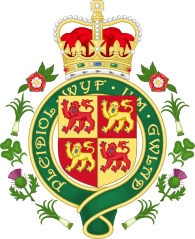
Coat of arms of Wales,
Source: Sodacan, CC BY-SA 3.0,
via Wikimedia Commons

The coat of arms of Wales shows a yellow and red quartered shield with a blue-armoured leopard in reverse color in each field. It goes back to the banner of Owain Glyndŵr (14th century Prince of Wales). The motto "Pleidiol Wyf I'm Gwlad" means "I am loyal to my country" and comes from the Welsh national anthem.
Source: Wikipedia (DE)

Location:

Source: Freeware, University of Texas Libraries, modyfied by: Volker Preuß
Map of the country:
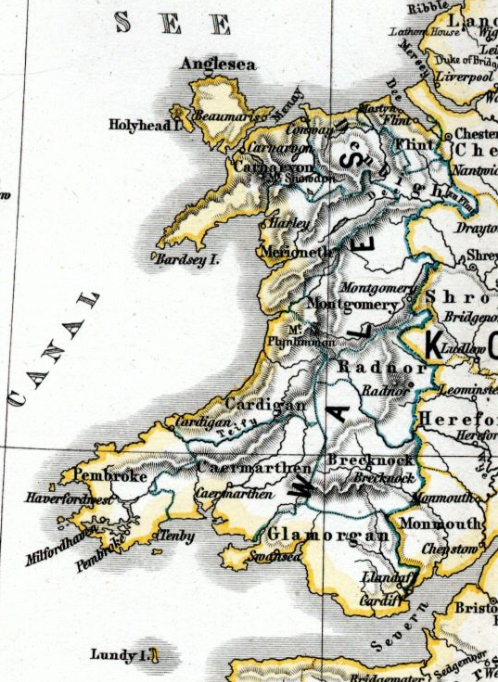
Source: Hand-Atlas für die Geschichte des Mittelalters und die neueren Zeit, von Spruner und Menke

Area: 8.006 square miles
Inhabitants: 3.138.631 (2018)
Density of Population: 392 inh./sq.mi.
Capital: Cardiff (Welsh: Caerdydd), 366.903 inh. (2019)
official Language: English, Welsh
Time Zone: Greenwich Meantime = CET – 1 h
Source:
Wikipedia (DE)

ca. 600 B.C. · Celtic settlement
57 B.C.–74 A.D. · to the Roman Empire, province of Britannia
from ca. 400 · withdrawal of the Roman legions, in the following years immigration of the Germanic tribes of the Angles, Saxons and Jutes to Britannia, which were later summarized under the term Anglo-Saxons, Wales becomes a retreat for the celtic British
1066 · the invading Normans defeat the Saxons at the battle of Hastings and establish their power in England and even in Wales
1301 · Edward I. subjects Wales ultimately
1416 · last national uprising of the Welshmen against the English yoke
1536 · Wales is united with England
1912 · concession of limited autonomy
1999 · a Welsh regional parliament begins its work
Source:
Atlas zur Geschichte,
Discovery '97,
Wikipedia (DE)

The name of the country goes back to the Germanic word "welsch", which initially meant the Celts in general, and later also the Romans. The figurative meaning of the word "welsch" as "foreign" has been preserved to this day. In Welsh, the country is called "Cymru," which derives from the Celtic word "Kom-brogi", meaning "countrymen".
Source: Wikipedia (DE)


![]()















